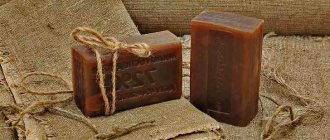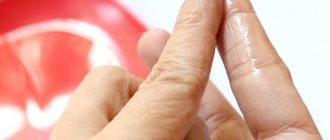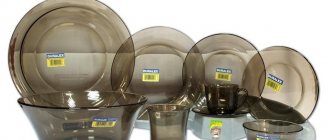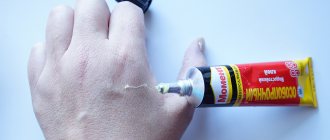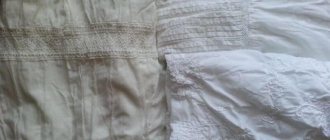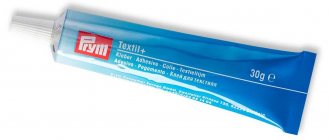Everyone knows the abilities of superglue, which can cope with urgent work at home. Using it, you can glue various materials, but still, the difference from special compounds is significant. You can strengthen the bonding of the necessary parts by adding baking soda to the glue. The combination of moment glue and soda leads to heating and speeds up the gluing process. The method is popular and will be covered in this article.
Combo set
Features of superglue
The main component contained in superglue is cyanoacrylate. Thanks to it, the parts are fastened several times faster - one might say instantly. It also contains plasticizers, stabilizers and other auxiliary components. It should be noted that superglue does not contain solvents, which is an advantage when fastening metal products.
Among the features of the quick-drying mixture, the following should be highlighted:
- After contact with air, the glue hardens very quickly. Therefore, when working with it, you do not need to leave the tube open.
- For fixation, the parts to be glued are treated with a thin layer of adhesive and pressed against each other with force. It is enough to hold in this position for no more than 1 minute.
- Bonded surfaces treated with super glue, provided the products are sufficiently strong, can withstand heavy loads - up to 150=250 kg/cm2.
- Cured glue has no color.
The miracle composition can be used to glue cracks or small gaps. First you need to fill the space with plaster mixture or concrete dust. Then treat with super glue, which will adhere well to the filler.
Precautionary measures
It takes no more than 3 seconds to polymerize cyanoacrylate, so you need to glue the plastic very quickly before the adhesive composition hardens.
The mixture can stick to your fingers, so wear gloves when working with it. If the product gets on a surface that is not subject to gluing, it must be wiped off immediately, or it can be pre-dissolved with acetone. If your fingers are stuck together due to superglue, apply a cotton pad soaked in acetone to the glued skin for half an hour. After soaking, the mass is easily wiped off the skin.
When working with baking soda, use a small funnel. It is convenient to measure the amount of powder through it. If there is no funnel, the substance is poured in small pinches.
During gluing, the room should be well ventilated to prevent poisoning by cyanoacrylate vapors.
Types of miracle glue
A piece of glass has broken off a shelf, a stone countertop has cracked, or a wooden piece has burst - all these problems can be eliminated by using superglue. There will be no problems with the purchase, but in order to choose the right composition, you need to roughly navigate the typology of glue. Each of them has its own disadvantages and advantages.
All glue is classified according to the number of components it contains into two types:
- One-component. Received the greatest distribution. The composition contains ethyl cyanoacrylate, due to which setting occurs after a few seconds. But for the process to be completely completed, it takes a day. Mainly used for fastening small parts.
- Two-component. When purchasing at a hardware store, what immediately catches your eye is the set of two tubes with different contents. When both components are combined, they react, so they require separate containers. The components are mixed immediately before use. No more than 2 minutes are allowed to complete the work. The glue is then covered with a film and hardens.
Two-component
Interaction mechanism
Superglue comes in one-component and two-component types. The first option is sold in one bottle. It hardens instantly, so its use is justified in emergency cases for gluing small elements. Two-part superglue consists of a tube of glue containing cyanoacrylate and a second bottle of alkaline agent. After mixing the components, a super-strong glue is obtained.
The mechanism of its interaction with soda is based on the ability of cyanoacrylate to react to alkali.
After combining both components, the polymerization reaction begins. A high temperature is generated, increasing the degree of adhesion, the glue quickly sets, tightly connecting the plastic. The resulting substance has properties and visual resemblance to acrylic, which is why it is often used to repair plastic bases. The method is popular among auto mechanics and computer scientists.
What can baking soda with superglue do?
Having analyzed the abilities of soda in combination with zinc acrylate, we will consider several standard situations where this composition can be used.
We repair the bumper
Car owners are familiar with many ways to repair a bumper when it is not possible to contact a service center. One such recipe is considered to be a combination of baking soda and superglue.
Action process:
- We remove the bumper from the car body and remove the fastening elements.
- To prevent further divergence of the crack, we drill a hole at its end.
- We clean the damaged area.
- Prepare a package of baking soda and a tube of superglue.
- We connect the edges of the cracked part and sprinkle with a generous amount of powder.
Bumper
- Apply glue to the prepared area so that the tip of the tube does not touch the surface of the bumper.
- Leave for half an hour for the damaged area to set.
- Repeat sanding the coating with further sanding.
Filling the cavity
In this case, a cavity refers to dents, deep scratches and depressions that appear as a result of wear of the part or careless use.
Filling the dent with the composition is of a different nature, but the technological process remains the same. Plastic is one of those materials that does not require sanding of parts. It is enough to degrease the coating using alcohol solutions or white spirit.
Cavity
Fill the cavity with baking soda powder and pour superglue on top. Thus, the powder part of the composition should be saturated with glue as best as possible. After 30 minutes of waiting, proceed to cleaning the part to be glued. To do this, take sandpaper and sand the bumper. To ensure that there are no scratches left on the surface, you need to sand it with a special felt wheel placed on a sanding machine or grinder.
Restoring the figured part of the part
Restoring the relief part of a part is also possible with a combination of glue and soda. By mixing these components, it is possible to securely fasten a broken element of a plastic product to the base, ensuring the proper level of wear resistance.
Plastic products are often fragile and prone to frequent breakdowns. Sometimes the damage is so severe that it is necessary to restore the damaged area, literally piece by piece. Conventional adhesives cannot cope with this task, and in this case, it is quite possible to use a composition of superglue and soda.
Recreating a badly damaged part requires a lot of strength and patience, as well as the makings of a sculptor, because the process involves the logical construction of an object according to the image in the head. To make the task easier, you need to break the whole process into several stages.
Curly details
The painstaking work of restoration, sometimes takes a lot of time, and therefore patience is an important condition for those who are about to take on the task. Each broken element is installed in place with preliminary application of glue and soda, and subsequent cleaning of the area. This way all the fragments are glued together.
Important! In case of deformation of the form when gluing small elements or an influx of adhesive mass, use abrasive materials. Restoration work is carried out no earlier than an hour after applying the glue.
Gluing plastic
Let's look at the general principle of gluing plastic:
- Sanding the coating. Clean the surface from excessive roughness. Excessive relief leads to a decrease in the quality of bonding. To correct the defect, use fine-grained abrasive material.
- Degreasing. It is carried out in order to improve the adhesive qualities of parts. Small particles and greasy deposits prevent the uniform distribution of the adhesive mass, which means that the bonding of structural elements will be somewhat worse. An alcohol-containing product is useful for processing.
- Gluing parts. The treated surfaces are covered with an even layer of glue and sprinkled with baking soda. There is no need to skimp on the powder, everything that is necessary for high-quality gluing will be absorbed, and blow away the rest.
- Polishing. After 30 minutes of drying the surface, sanding is carried out with sandpaper. To improve the appearance of the coating, use a felt attachment on a grinder or sander.
Sealing the pool
It’s an unpleasant situation when, while swimming, you suddenly discover that the pool has leaked - a hole has formed somewhere in the side. In this case, it is necessary to urgently take measures to eliminate the problem so as not to aggravate the situation by further discrepancy of the defective area.
In this situation, there is no way to do without a patch, which slightly complicates the process of using the combined composition and requires more skill.
Let's take a closer look:
- If a leak is detected, it is necessary to immediately drain the water to a level below the damage line. Ideally, it is better to remove the water completely.
- Dry the area. Do not use special products to dry the surface. This may cause the hole to diverge.
- Degrease. We treat the surface around the hole with available alcohol-based products.
- Apply glue. The adhesive composition is evenly distributed over the damaged area and patch.
- Sprinkle soda. Immediately after the glue has been applied, pour soda on it and blow off the excess.
- Glue it together. Place the patch over the hole in the pool and press firmly on both surfaces. Maintain in this position for about 1 minute.
- Sanding. Remove excess glue with sandpaper.
Important! All work to eliminate leaks in the pool is carried out very quickly, since the combined composition is applied to both surfaces, which complicates the gluing process.
What you need to know before using the composition
- If the type of surfaces that need to be glued are very smooth, it is recommended to sand them to create roughness. This will allow the composition to better interact with surfaces and penetrate deeper.
- Before applying the composition, the surface must be prepared - cleaned of dirt and other deposits, degreased and dried thoroughly.
- You don't have to use only baking soda. The alkaline composition itself is important to us, so calcined is also quite suitable.
- It is better to choose superglue that has the minimum setting time.
If it is necessary not to glue the surfaces, but to fill the cavity, then the bouquet algorithm of actions is as follows:
- if it is plastic or plastic, then there is no need to clean it before using the composition;
- pour soda into the cavity so that it does not reach the edge a little, then pour superglue to the edge;
- stir the mixture and leave for 15-20 minutes;
- If there is a bulge left, carefully clean it and then polish it.
This composition is no worse than two-component adhesive mixtures. The only difference is that you can easily, cheaply and very quickly make it yourself. This universal adhesive is indispensable both at home, in the garage, and at work.
Instructions for using the mixture for repair
Bonding products with cyanoacrylate glue and sodium bicarbonate will help in many types of repairs. The mixture can hold broken parts together, fill a chip, repair a machine screw and similar replacement parts. There are a number of rules for gluing products during the repair process:
- take a suitable abrasive, clean both surfaces of the products (this will help remove dirt and open small pores into which the adhesive mass will penetrate);
- moisten a cloth with alcohol or solvent, degrease the surfaces (otherwise the fats may cause the material to peel off);
- pour baking soda into the defect or sprinkle it on the surface;
- pour soda with glue;
- connect the parts as quickly as possible (if required);
- blow off the remaining soda;
- After 15 minutes, you can begin grinding, polishing, and other actions with the resulting adhesive seam.
Useful tips
In order for the glue to last longer, it is important to know the storage rules. It is recommended to pay attention to the following tips:
- Superglue of any brand has a fluid composition, so if it has a viscous consistency when purchased, it means that the storage conditions were not met. When the glue does not flow out of the tube, go to the store and change the product.
- Store superglue in the refrigerator. This method will extend the shelf life.
- If the lid does not fit smoothly to the tube or there is slight damage to the packaging, then keeping the glue in the refrigerator becomes dangerous: the substance is quite toxic.
By following the recommendations above, it will not be difficult to deal with the repair quickly and efficiently.
How to store and care
Do-it-yourself slime is very capricious and short-lived. To extend its service life, it is worth remembering a few recommendations:
- To store the product, use a tightly closed plastic container.
- Keep the toy away from heat sources and the sun so that it does not dry out.
- If the product is too soft, you can put it in a container with a small amount of salt and close it tightly. Salt can draw out excess liquid, this will restore the slime's elasticity.
- A toy that is too hard can be softened with a few drops of water added to the storage container.
- It is necessary to avoid contact with surfaces made of pile, as this will render the toy unusable.
Glue and soda are not only good helpers in everyday life, helping to repair plastic objects, but also means with which you can make an exciting toy. This product develops fine motor skills, calms, and relieves stress. Additionally, it can be used to clean your keyboard and clothes.
Application using the example of a car bumper
As you know, many motorists in our country usually try to cope with various types of breakdowns on their own. And in this case, super glue can become a real lifesaver. For example, motorists often repair cracks in a car bumper using approximately the following method:
- Remove the bumper from the car. Drill a hole at the very end of the crack to prevent it from spreading.
- Spread the edges of the cracked bumper and clean them with sandpaper. Coat the edges with superglue. Sprinkle them generously with soda.
- Connect the edges of the crack and wait half an hour. Sand the closed crack with sandpaper.
Filling voids
Using an adhesive composition with soda, you can fill the voids that form after an impact or breakage.
They also remove pits and depressions on other products. For such minor repairs, plastic products do not need to be sanded with sandpaper; just wipe off the grease is enough.
But materials other than plastic still need to be rubbed down. First, pour soda into the void, then pour glue so that it saturates the powder well. It is necessary to make sure that there is a sufficient amount of superglue available before starting work.
If the void is quite large, then it must be filled gradually in layers so that there is no soda left in it without impregnation, otherwise the quality of the adhesive joint will be poor. The seam can be polished and sanded only after 30 minutes.
Once again about storing cyanoacrylate
UPD:
(about dental materials, very interesting)
www.bondic.com - liquid photocurable polymer in a tube, and immediately assembled UV LED
Then another crazy idea came to my mind: a hybrid chemical “jet” 3D printer
, printing cyanoacrylate with an aqueous solution of a slightly alkaline agent, with an FDM extruder for printing polyethylene or polypropylene formwork. A drug addict's holiday, in short.
Problems
- Print speed (not clear what).
- Poisonous a.
- Difficulty storing consumables (a barrel of Cosmophene, they say, dries out in 8 months).
- Difficulty in printing in domestic conditions (the air is humid).
- Heating the workpiece (exothermic polymerization reaction).
- Part destruction at 80..100 degrees Celsius.
- Delamination of formwork, shrinkage during cooling.
Advantages
- Powerful adhesion of the part to the printer “table”.
- Larger dimensions
of printed products. - Products of complex shapes, with easily detachable formwork.
- Relative availability of consumables.
Absurd? Yes, I only fix armrests :-) Help with comments if you have the desire and experience.
Not many people know that superglue and baking soda can be a great pair. Superglue has firmly entered our lives and has found application in various areas. Its adhesive properties can be supplemented with regular soda.
Method 2. Less neat, but simpler
The second option for repairing the product is considered the simplest and is suitable even for those who are not well versed in repairs. The result is not as neat as in the first case, but the process itself is very simple. The repair proceeds according to the following scheme:
- A small amount of Super Glue is applied to the two broken parts. After which they are connected to each other and, if possible, fixed.
- A small layer of soda is distributed on top.
- The product is fixed for 3-5 seconds - just put it aside so that the seam is not disturbed.
In principle, this is enough. After 2 hours, the most durable gluing is obtained, even in the case where the soda did not have direct access to the joint of the parts being joined. If there is a need to build up the bonding layer, the procedure is repeated the required number of times.
Advice! Using the “right” soda will simplify the polymerization process. It should be of uniform consistency, without pebbles or raw grains. The smaller the soda grains, the better.
Use for cleaning dishes
From frequent use, kitchen utensils lose their shine. Pans and pots are especially affected. You can clean utensils not only using household chemicals based on hydrochloric acid, but also using home remedies. There are several proven ways to get rid of dirt that our mothers and grandmothers successfully used.
You should take:
- soda ash - 0.5 kg;
- glue - 400 ml;
- laundry soap 72% - 200 g;
- water - 20 l;
- large enameled basin.
